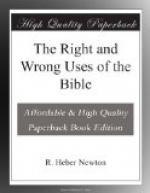V.
These writings should be read critically, until we can decipher the successive hands working upon them, and interpret them accordingly.
Few, if any, of the books of the Bible stand now as they came from their original authors. Nearly all have been re-edited; most of them many times. Some of them have been worked over by so many hands, and have undergone such numerous and serious changes, that the original writer would scarcely identify his work. The historical writings of the Old Testament take up into them all sorts of materials, from all sorts of sources. If the annals of the Venerable Bede, the father of English history had been re-written again and again through the subsequent centuries; abridged, enlarged, interpreted by each editor; the accumulating knowledge and growing experience of the nation read into his simple chronicles; we should appreciate the critical care needful in studying our edition of Bede if we would know the real original. Very much such care is necessary if we are to use the Old Testament histories aright for information. It is as though there were several surfaces to the parchment on which the histories were written, on each successive film of which, in finest tracery, an older record was inscribed.
Genesis, for example, presents us, at every step of what seems a consecutive story, with successive layers of tradition, through which we must work our way most carefully if we would really understand the book. We readily observe a twofold tradition of the Creation in the opening chapters of Genesis, differing very materially: a sign to us, if we need it, that there was no one authoritative account of the Creation current in Israel. Little attention is required to note a double version of the story of the flood, whose artless piecing together is the cause of the confusions and contradictions that puzzle many readers. The deciphering of this double tradition of the flood first started criticism upon the true track of Biblical study. The frequently recurring phrase, “These are the generations,” or beginnings, indicates the insertion of fragments of a work giving an account of the origin of the world, of the races of earth, of language, of the Jewish people, etc.; a work called by the critics “The Book of Origins.” In the fourteenth chapter there is what seems to be a very ancient non-Jewish fragment of history, torn possibly from some Syrian writing, which gives a tale of Abraham’s prowess in war.
And even in one and the same tale of tradition, we apparently find strata of thought laid down by successive ages. There are extant to-day parchments in which, for lack of other material, a writer has scratched partially away an earlier manuscript, and written over it another book. Such a palimpsest is Genesis. “A legend of civilization is written over a solar-myth, and a tribal legend over the legend of civilization, and a theocratic legend over the tribal."[38]




